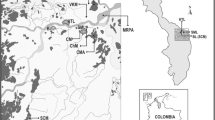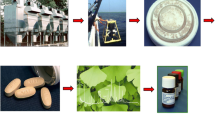Abstract
Gold (Au) is ubiquitous in the environment and mined commercially at numerous locations worldwide. It is also an allergen that induces dermatitis in sensitive individuals. Gold concentrations were comparatively elevated in samples collected near gold mining and processing facilities, although no data were found for birds and non-human mammals. Maximum gold concentrations reported in abiotic materials were 0.001 μg L-1 in rainwater; 0.0015 μgL-1in seawater near hydrothermal vents vs. <0.00004–0.0007 μg L-1 elsewhere; 5.0 μg kg-1 dry weight (DW) in the Earth's crust; 19.0 μg L-1 in a freshwater stream near a gold mining site; 440 μg kg-1 DW in atmospheric dust near a high traffic road; 843 μg kg-1 DW in alluvial soil near a Nevada gold mine vs. <29 μg kg-1 DW premining; 2.53 mg kg-1 DW in snow near a Russian smelter vs. <0.35 mg kg-1 DW at a reference site; 4.5 mg kg-1 DW in sewage sludge; 28.7 mg kg-1 DW in polymetallic sulfides from the ocean floor; and 256.0 mg kg-1 DW in freshwatersediments near a gold mine tailings pile vs. <5 μg kg-1 DW prior to mining. In plants, elevated concentrations of 19 μg Au kg-1 DW were reported in terrestrial vegetation near gold mining operations vs. <4 μg kg-1 DW at a reference site; 37 μg kg-1 DW in aquatic bryophytes downstream from a gold mine; 150 μg Au kg-1 DW in leaves of beans grown in soil containing 170 μg kg-1 DW; up to 1.06 mg kg-1 DW in algal mats of rivers receiving gold mine wastes; and 0.1–100 mg kg-1 DW in selected gold accumulator plants. Fish and aquatic invertebrates contained 0.1–38.0 μg Au kg-1 DW. In humans, gold concentrations up to 1.1 μg L-1 were documented in urine ofdental technicians vs. 0.002–0.85 μg L-1 in reference populations; 2.1 μg L-1 in breast milk, attributed to gold dental fillings and jewelry of mothers; 1.4 mg kg-1 DW in hairof goldsmiths vs. a normal range of 6–880 μg kg-1 DW; 2.39 mg L-1 in whole blood of rheumatoid arthritis patients receiving gold thiol drugs to reduce inflammation (chrysotherapy) vs. a normal range of 0.2–2.0 μg L-1; and 60.0 to 233.0 mg kg-1 fresh weight (FW) in kidneys of rheumatoid arthritis patients undergoing active chrysotherapy vs. <42.0 mg kg-1 FW kidney 140 months posttreatment.
Similar content being viewed by others
References
Ahnlide, I., Bjorkner, B., Bruze, M. and Moller, H.: 2000, 'Exposure to metallic gold in patients with contact allergy to gold sodium thiosulfate', Cont. Dermat. 43, 344–350.
Awadallah, R. M., Mohamed, A. E., Abou-El-Wafa, M. H. and Rashed, M. N.: 1995, 'Assessment of trace element concentrations in fenugreek and lupin planted in the experimental farm, High Dam Lake Development Authority, Gerf Hussein beach locality, Egypt', Pakistan J. Sci. Indus. Res. 38, 51–60.
Bagatto, G. and Shorthouse, J. D.: 1994, 'Mineral concentrations within cells of galls induced by Hemadas nubilpennis (Hymenoptera: Pteromalidae) on lowbush blueberry: Evidence from cryoanalytical scanning electron microscopy', Canad. J. Bot. 72, 1387–1390.
Barbante, C., Cozzi, G., Capodaglio, G., Van de Velde, K., Ferrari, C., Boutron, C. and Cescon, P.: 1999, 'Trace element determination in alpine snow and ice by double focusing inductively coupled plasma mass spectrometry with microconcentric nebulization', J. Anal. Atom. Spectr. 14, 1433–1438.
Begerow, J., Sensen, U., Wiesmuller, G. A. and Dunemann, L.: 1999, 'Internal platinum, palladium, and gold exposure in environmentally and occupationally exposed persons', Zbl. Hyg. Umweltmed. 202, 411–424.
Caroli, S., Senofonte, O., Violante, N., D'Ilio, S., Caimi, S., Chiodo, F. and Menditto, A.: 1998, 'Diagnostic potential of hair analysis as applied to the goldsmith sector', Microchem. J. 59, 32–44.
Davies, B. E.: 1997, 'Deficiencies and toxicities of trace elements and micronutrients in tropical soils: Limitations of knowledge and future research needs', Environ. Toxicol. Chem. 16, 75–83.
Dissanayake, A. B. and Kritsotakis, K.: 1984, 'The geochemistry of Au and Pt in peat and algal mats-A case study from Sri Lanka', Chem. Geol. 42, 61–76.
Ehrlich, A. and Belsito, D. V.: 2000, 'Allergic contact dermatitis to gold', Cutis 65, 323–326.
Eisler, R.: 1981, Trace Metal Concentrations in Marine Organisms, Pergamon Press, New York, 687 pp.
Eisler, R.: 2003, 'Health risks of gold miners: A synoptic review', Environ. Geochem. Health. 25(3), 325–345.
Eisler, R., Clark Jr., D. R., Wiemeyer, S. N. and Henny, C. J: 1999, 'Sodium Cyanide Hazards to Fish and Other Wildlife from Gold Mining Operations', in J. M. Azcue (ed.), Environmental Impacts of Mining Activities: Emphasis on Mitigation and Remedial Measures, Springer-Verlag, Berlin, pp.55–67.
Elevatorski, E. A.: 1981, Gold Mines of the World, Minobras, P.O. Box 262, Dana Point, California, 107 pp.
Fowler Jr., J. F.: 2001, 'Gold', Amer. J. Cont. Dermat. 12, 1–2.
Gordeyev, V. V., Yegorov, A. S., Lisitsyn, A. P., Letokhov, V. S., Pakhomov, D. Y. and Gulevich, V. M.: 1997, 'Dissolved gold in surface waters of the northeastern Atlantic', Geochem. Int. 35, 1007–1015.
Gordeyev, V. V., Yegorov, A. S., Radayev, V. N. and Zubow, I. V.: 1991, 'Gold as a possible tracer of hydrothermal influence on bottom waters', Oceanology 31, 178–182.
Greer, J.: 1993, 'The price of gold: Environmental costs of the new gold rush', The Ecologist 23, 91–96.
Gregurek, D., Melcher, F., Niskavaara, H., Pavlov, V. A., Reimann, C. and Stumpfl, E. F.: 1999, 'Platinum-group elements (Rh, Pt, Pd) and Au distribution in snow samples from the Kola Peninsula, NW Russia', Atmospher. Environ. 33, 3281–3290.
Hannington, M., Herzig, P., Scott, S., Thompson, G. and Rona, P.: 1991, 'Comparative mineralogy and geochemistry of gold-bearing sulfide deposits on the mid-ocean ridges', Mar. Geol. 101, 217–248.
Herzig, P. M., Hannington, M. D., Fouquet, Y., Stackelberg, U. V. and Petersen, S.: 1993, 'Gold-rich polymetallic sulfides from the Lau Back Arc and implications for the geochemistry of gold in sea-floor hydrothermal systems of the southwest Pacific', Econ. Geol. 88, 2182–2209.
Hirohata, S.: 1996, 'Inhibition of human B cell activation by gold compounds', Clin. Immunol. Immunopathol. 81, 175–181.
Karamushka, V. I. and Gadd, G. M.: 1999, 'Interaction of Saccharomyces cerevisiae with gold: Toxicity and accumulation', Biometals 12, 289–294.
Kirkemo, H., Newman, W. L. and Ashley, R. P.: 2001, Gold, U.S. Geol. Surv., Box 25286, Federal Center, Denver, Colorado 80225, 23 pp.
Kist, A. N.: 1994, 'Investigation of element speciation in atmosphere', Biol. Trace Elem. Res. 43-54, 259–266.
Krachler, M., Prohaska, T., Koellensperger, G., Rossipal, E. and Stingeder, G.: 2000, 'Concentrations of selected trace elements in human milk and in infant formulas determined by magnetic sector field inductively coupled plasma-mass spectrometry', Biol. Trace Elem. Res. 76, 97–112.
Lee, E. E. and Maibach, H. L.: 2001, 'Is contact allergy in man lifelong? An overview of patch test follow-ups', Cont. Dermat. 44, 137–139.
Leybourne, M. I., Goodfellow, W. D., Boyle, D. R. and Hall, G. E. M.: 2000, 'Form and distribution of gold mobilized into surface waters and sediments from a gossan tailings pile, Murray Brook massive sulphide deposit, New Brunswick, Canada', Appl. Geochem. 15, 629–646.
Lottermoser, B. G.: 1995, 'Noble metals in municipal sewage sludges of southeastern Australia', Ambio 24, 354–357.
McBride, M. B., Richards, B. K., Steenhuis, T., Russo, J. J. and Sauve, S.: 1997, 'Mobility and solubility of toxic metals and nutrients in soil fifteen years after sludge application', Soil Sci. 162, 487–500.
Merchant, B.: 1998, 'Gold, the noble metal and the paradoxes of its toxicology', Biologicals 26, 49–59.
Messerschmidt, J., von Bohlen, A., Alt, F. and R. Klockenkamper, R.: 2000, 'Separation and enrichment of palladium and gold in biological and environmental samples, adapted to the determination by total reflection X-ray fluorescence', Analyst 125, 397–399.
Miller, J. R., Rowland, J., Lechler, P. J., Desilets, M. and Hsu, L. C.: 1996, 'Dispersal of mercury-contaminated sediments by geomorphic processes, Sixmile Canyon, Nevada, U.S.A.: Implications to site characterization and remediation of fluvial environments', Water, Air, Soil Pollut. 86, 373–388.
Mohamed, A.: 1999, 'Environmental variations of trace element concentrations in Egyptian cane sugar and soil samples (Edfu factories)', Food Chem. 65, 503–507.
Moss, R., Scott, S. and Binns, R. A.: 1997, 'Concentrations of gold and other ore metals in volcanics hosting the Pacmanus seafloor sulfide deposit', JAMSTEC J. Deep Sea Res. 13, 257–267.
Ohta, K., Isiyama, T., Yokoyama, M. and Mizuno, T.: 1995, 'Determination of gold in biological materials by electrothermal atomic absorption spectrometry with a molybdenum tube atomizer', Talanta 42, 263–267.
Oluwole, A. F., Ojo, J. O., Durosinmi, M. A., Asubiojo, O. I., Akanle, O. A., Spyrou, N. M. and Filby, R. H.: 1994, 'Elemental composition of head hair and fingernails of some Nigerian subjects', Biol. Trace Elem. Res. 43-45, 443–452.
Prohaska, T., Kollensperger, G., Krachler, M., De Winne, K., Stingeder, G. and Moens, L.: 2000, 'Determination of trace elements in human milk by inductively coupled plasma sector field mass spectrometry (ICP-SFMS)', J. Anal. Atomic Spectr. 15, 335–340.
Puddephatt, R. J.: 1978, The Chemistry of Gold, Elsevier, Amsterdam, 274 pp.
Pyatt, F. B.: 1999, 'Comparison of foliar and stem bioaccumulation of heavy metals by Corsican pines in the Mount Olympus area of Cyprus', Ecotoxicol. Environ. Safe. 42, 57–161.
Rashed, M. N. and Awadallah, R. M.: 1998, 'Trace elements in faba bean (Vicia faba L) plant and soil as determined by atomic absorption spectroscopy and ion selective electrodes', J. Sci. Food Agric. 77, 18–24.
Sabti, H., Hossain, M. M., Brooks, R. R. and Stewart, R. B.: 2000, 'The current environmental impact of base-metal mining at the Tui Mine, Te Aroha, New Zealand', J. Roy. Soc. N.Z. 30, 197–208.
Sadler, P. J.: 1976, 'The biological chemistry of gold: A metallo-drug and heavy-atom label with variable valency', Struct. Bonding 29, 171–215.
Samecka-Cymerman, A. and Kempers, A. J.: 1998, 'Bioindication of gold by aquatic bryophytes', Acta Hydrochim. Hydrobiol. 26, 90–94.
Shakeshaft, J., Clarke, A. K., Evans, M. J. and S. C. Lillicrap, S. C.: 1993, 'X-ray Fluorescence Determination of Gold In Vivo', in J. D. Eastman and K. J. Ellis, (eds), Human Body Composition, Plenum Press, New York, pp. 307–310.
Suarez, I., Ginarte,M., Fernandez-Redondo, V. and Toribo, J.: 2000, 'Occupational contact dermatitis due to gold', Cont. Dermat. 43, 367–368.
Terashima, S., Katayama, H. and Itoh, S.: 1991, 'Geochemical behavior of gold in coastal marine sediments from the southeastern margin of Japan Sea', Mar. Mining 10, 247–257.
Terashima, S., Nakao, S., Mita, N., Inouchi, Y. and Nishimura, A.: 1995, 'Geochemical behavior of Au in terrigenous and pelagic marine sediments', Appl. Geochem. 10, 35–44.
Tsurita, K., Matsunaga, K., Suzuki, K., Suzuki, R., Akita, H., Washimi, Y., Tomitaka, A. and Ueda, H.: 2001, 'Female predominance of gold allergy', Cont. Dermat. 44, 55–56.
Vamnes, J. S., Morken, T., Helland, S. and Gjerdet, N. R.: 2000, 'Dental gold alloys and contact hypersensitivity', Cont. Dermat. 42, 128–133.
Van de Velde, K., Barbante, C., Cozzi, G., Moret, I., Bellomi, T., Ferrari, C. and C. Boutron, C.: 2000, 'Changes in the occurrence of silver, gold, platinum, palladium and rhodium in Mont Blanc ice and snow since the 18th century', Atmosph. Environ. 34, 3117–3127.
Weber, V. A., Lehrberger, G. and Morteani, G.: 1997, 'Gold und Arsen in Pilzen,Moosen und Baumnadeln-Biogeochemische Aspekte einer 'geogenen Atlast' im Moldanubikum des Oberpfalzer Waldes bei Oberviechtach', Geol. Bavarica 102, 229–250.
Zhuk, L. I., Mikholskaya, I. N., Danilova, E. A. and Kist, A. E.: 1994, 'Mapping using human blood composition data', Biol. Trace Elem. Res. 43-45, 371–381.
Author information
Authors and Affiliations
Rights and permissions
About this article
Cite this article
Eisler, R. Gold Concentrations in Abiotic Materials, Plants, and Animals: A Synoptic Review. Environ Monit Assess 90, 73–88 (2004). https://doi.org/10.1023/B:EMAS.0000003567.66682.d8
Issue Date:
DOI: https://doi.org/10.1023/B:EMAS.0000003567.66682.d8




